Design The Perfect Patio Space With This Advice From Top Garden Designers
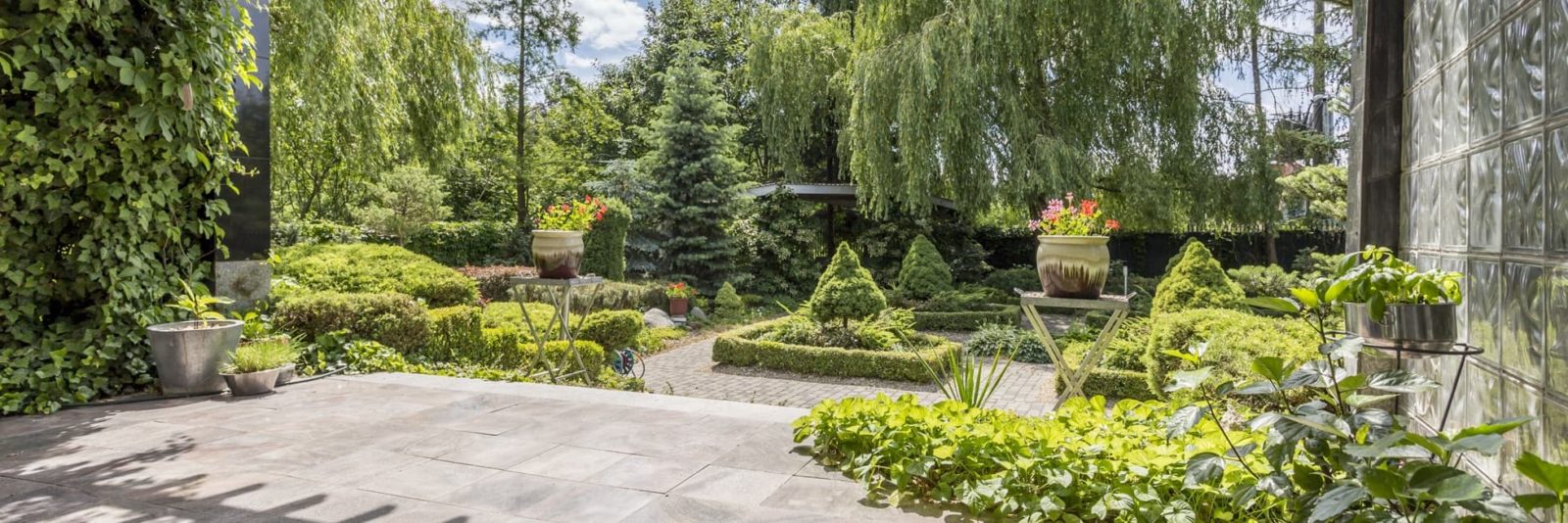

Elizabeth is a Permaculture Garden Designer, Sustainability Consultant and Professional Writer, working as an advocate for positive change. She graduated from the University of St. Andrews with an MA in English and Philosophy and obtained a Diploma in Applied Permaculture Design from the Permaculture Association.
Reviewed By DAN ORI

Dan has over 27 years’ under his belt caring for plants and gardens. Working as a Horticultural Instructor and Consultant, he draws on a diverse range of experience that includes working as a Head Gardener, Tree Surgeon, Garden Centre Trouble Shooter, and writer of academic papers. Dan has a Level 3 Diploma in Horticulture and is currently a candidate for the RHS’s most prestigious award – The Master of Horticulture.
Contributions From DANNY CLARKE

Danny Clarke ('The Black Gardener') is a British Horticulturist and Garden Designer. He is probably best known for his TV presenting roles on the BBC's Instant Gardener, his time on the ITV This Morning team and Filthy Garden SOS aired on Channel 5. He also co-directs CIC Grow 2 Know, a charitable organisation encouraging diversity in horticulture.

Flo Headlam is a Garden Designer, Writer & TV Presenter. She is currently a Designer and Presenter on BBC Garden Rescue, having previously worked in the BBC Gardeners' World team. Flo has a Diploma in Garden Design from Capel Manor and has experience working on commercial projects and community gardens.

Ann-Marie is an award-winning Garden Designer who has worked on private, commercial and charity gardens. Her experience includes work on Grade 1 and 2 listed gardens and Gold-Medal winning show gardens at RHS Chelsea. She was recently featured in Sky Arts show ‘Art Of The Garden'. In 2021, Ann-Marie published her first book, ‘My Real Garden’.

The founder of Studio Ikram, Humaira has worked as a professional Garden Designer for over 10 years. She also runs a Garden Design course at KLC School of Design and is a Garden Adviser to the RHS. Humaira regularly contributes to BBC Gardener’s Question Time and has also featured on flower shows across Netflix and the BBC.
Creating the perfect patio is important if you want to use your garden to entertain this coming summer, and throughout the year.
The perfect patio really can turn your garden from a pretty and productive space into a space where you really want to hang out and spend time.
One of the most important things to remember if you want to create a perfect patio is that there really isn’t a one-size-fits-all solution that will work for every garden and every individual.
It is important to think carefully about your site, and about what you really want before you determine all the choices for the patio and what surrounds it, as Humaira Ikram, an award-winning Garden Designer explains:

“It’s really important to think about how you want to use your garden and build it from that. If you want it to be a space for entertaining, build your garden around a seating area.
“Don’t be afraid to plant everywhere – surround yourself in nature. You can use plants to divide your garden up into sections you want it to be. Also, doing some research on what plants you should grow is really useful!”
But if you want to make sure you have a party-ready patio, to welcome friends and family and to enjoy the natural world, then there are certain features that most patios will share.
Below, we’ll take a look at key elements, some design tips, and some planting suggestions that could help you create the perfect outdoor ambience for entertaining this summer.
Essential Elements For A Perfect Patio
- Somewhere to eat outside (and perhaps somewhere to cook or prepare food outside too).
- An area with comfortable seating – a relaxation or ‘chill out’ zone.
- Surrounding planting – in planters, raised beds, containers, or edging beds or borders. (A patio will derive much of its character and charm from the plants that surround it in your garden, so you cannot just think about hard, man-made elements alone.)
- A heat source – a fire pit or chiminea is wonderful as a focal point. It can create the right vibe as well as allowing you to enjoy the garden into the evening and after dark.
- Eco-friendly lighting can also be a useful feature. Clever and sensible lighting solutions can set the mood, and again, make it easier to enjoy your garden when light levels fall, and late into an evening.
Of course, there are plenty of other elements that you may wish to add.
For example, you might like to create a covered area so you can sit out in all weathers, and/or structures for shade – but these core things are usually close to the top of the list.
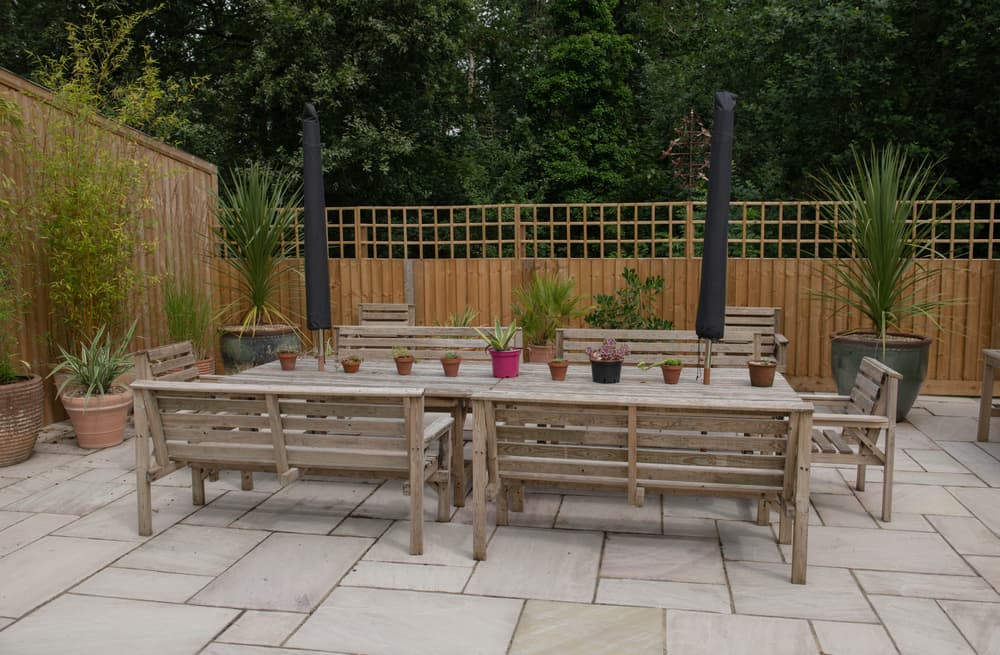
These are some of the first things you should consider.
In our suggested patio plan above, you can see one way in which these different elements could be combined for great results.
General Design & Layout Tips
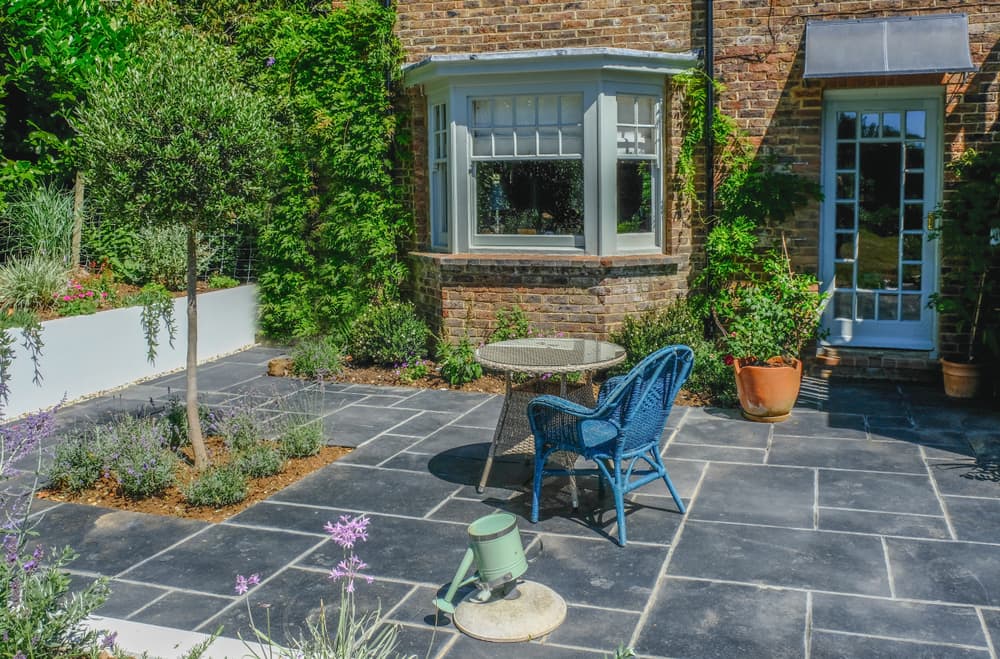
When designing the perfect patio, once you have decided on the main elements you would like to include, you need to think about how to combine those elements to create the perfect overall design for your space, and your particular wishes.
Here are some general design and layout tips to think about as you create your patio plan:
Think About Sunlight & Shade
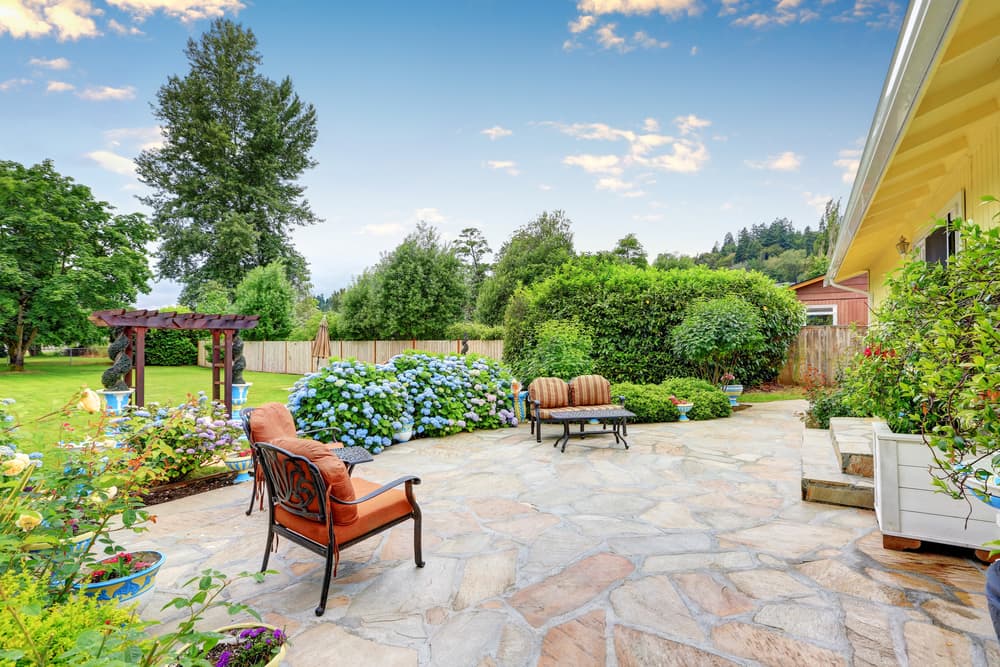
Many people in the UK will wish to position a patio where there will be as much sun as possible.
A south-facing position can be perfect to maximise rays, but sometimes, shade may be beneficial.
It can be nice to have a sunny spot which enjoys afternoon and evening sun for dining – but in a seating area, it might be nice to be able to sit in the shade, as well as in full sun.
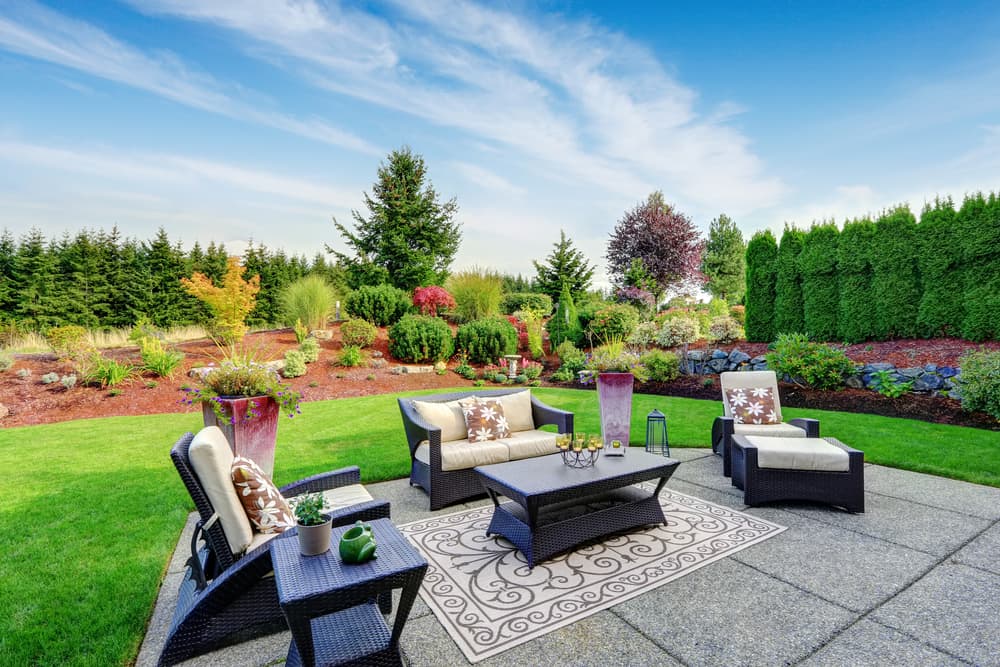
These things should always be considered in the layout.
A dining area relatively open to the south and west can be great.
A seating area open to the south and east can be a lovely spot for a morning cup of coffee, but may be nicer if shaded at least in part during the afternoon on hot summer days.
But be sure to think about your particular garden, and when and how you personally want to use the space.
Consider Privacy
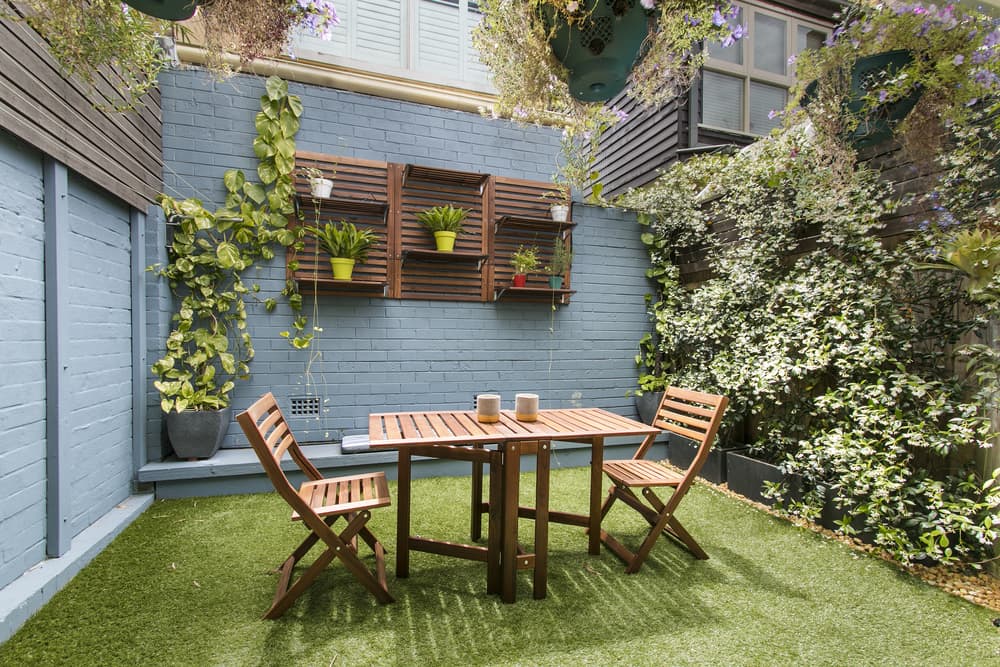
Privacy is a key consideration, especially in city or town gardens which can often tend to be overlooked, as Flo Headlam, Garden Designer & TV Presenter, shares:
“Sometimes, you might want to screen off a patio for some privacy from the rest of the garden. This means you might want to grow things at a taller height.”
Some people are worried about how privacy can be achieved without casting excessive amounts of shade.
Fortunately, there are many solutions to consider. Remember, you don’t necessarily need to choose large trees or other dominating plants to obtain a sense of privacy.
Blocking sight lines with smaller trees – such as a small fruit tree in a pot, or partially screening an area with taller perennials or ornamental grasses, for example, can often achieve a private feel without making a small patio garden feel hemmed in (or casting too much shade).
Be Practical
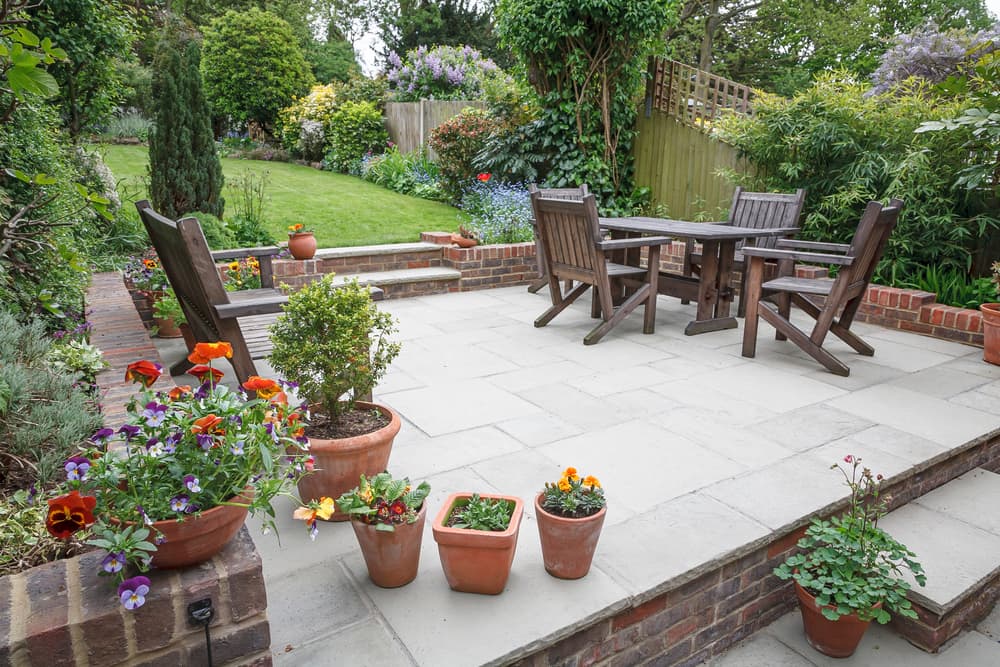
Sometimes, creating the perfect patio is about a trade-off between gaining the best environmental conditions, and being as close as possible to the back door of your home.
“Use lots of pots around a patio,” suggests Garden Designer Ann-Marie Powell.
“I think once you’ve designed your garden, it’s kind of done, but if you’ve got pots, it can change up what you’re wanting to do every single year.
“Once gardening gets its roots into you, which it will, then you’re constantly going to be interested in experimenting with new plants, so pots are great for this.”
It can be beneficial to have a patio right outside the back of your home, though do think about the fact that, depending on your home’s orientation, that might not always be the perfect spot.
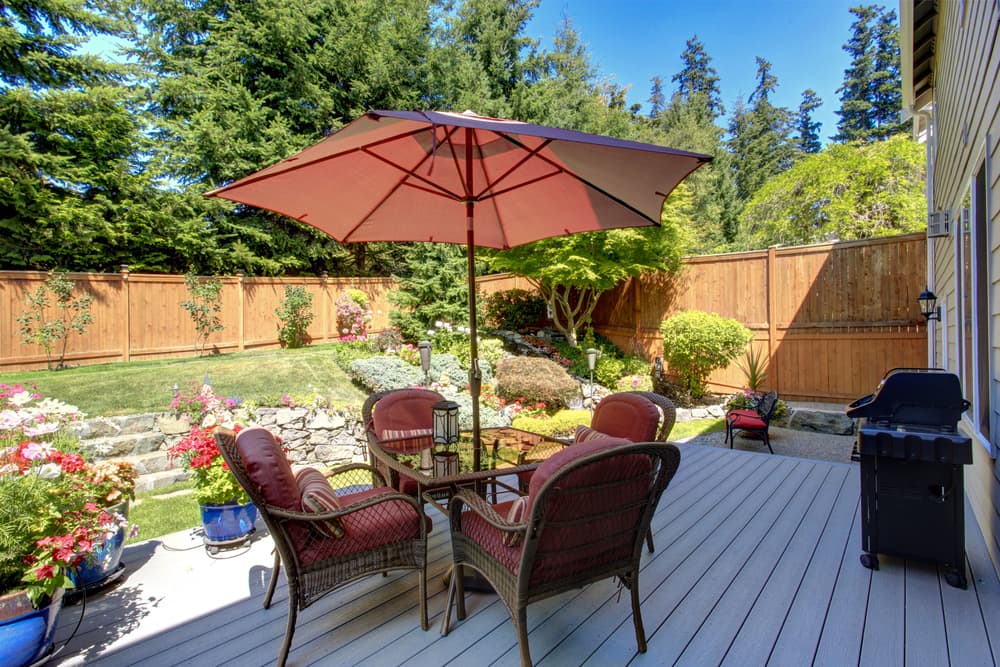
Balance the needs for practicality with the characteristics of the space to make sure you reach the best possible layout and design.
Think about how easy it will be to carry food and drinks out from your home.
And consider steps to make the space as comfortable and useable as possible throughout the day and throughout the year – no matter what the conditions.
These were some of the core considerations which went into creating our suggested patio plan.
While this exact layout and design might not be perfect for you and your particular site, it should give you a place to start when designing a patio for your garden.
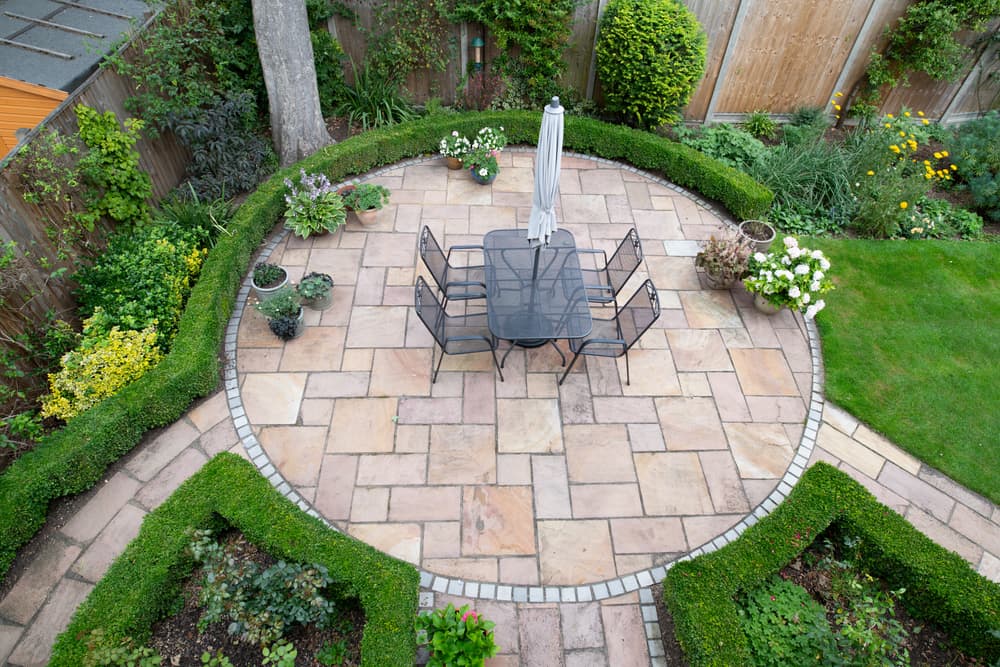
One other thing to emphasise is that practicality also means being practical when it comes to the materials and solutions you choose to create your new patio.
For budgetary reasons, and environmental ones, we recommend that you try to opt for natural or reclaimed materials as much as possible.
As you can see in our suggested plan, raised beds surrounding the main entertainment areas have reclaimed wood bed edging.
Wood-toned decking and warm sandstone paving or terracotta tiles could also be reclaimed.
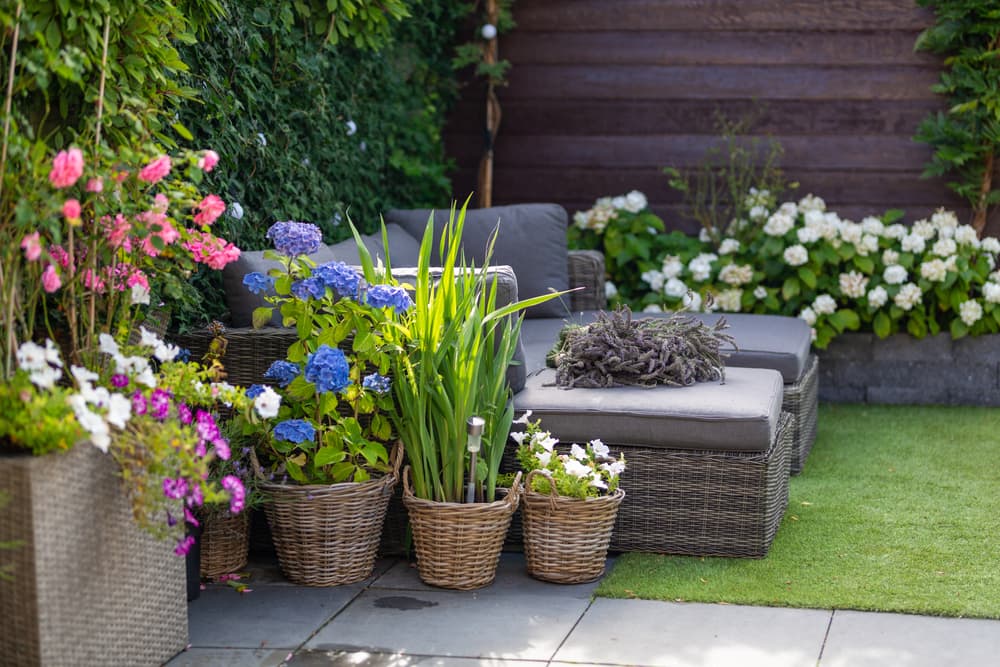
And broken tiles could also be used to create the decorative mosaic feature around the fire pit.
Glass bottles and other such materials can be useful in the creation of light lanterns – and can also be used in a wide range of other ways in your garden.
Containers, and the trellis suggested on the west-facing wall of this suggested design could also be made from natural or reclaimed materials.
Planting Inspiration
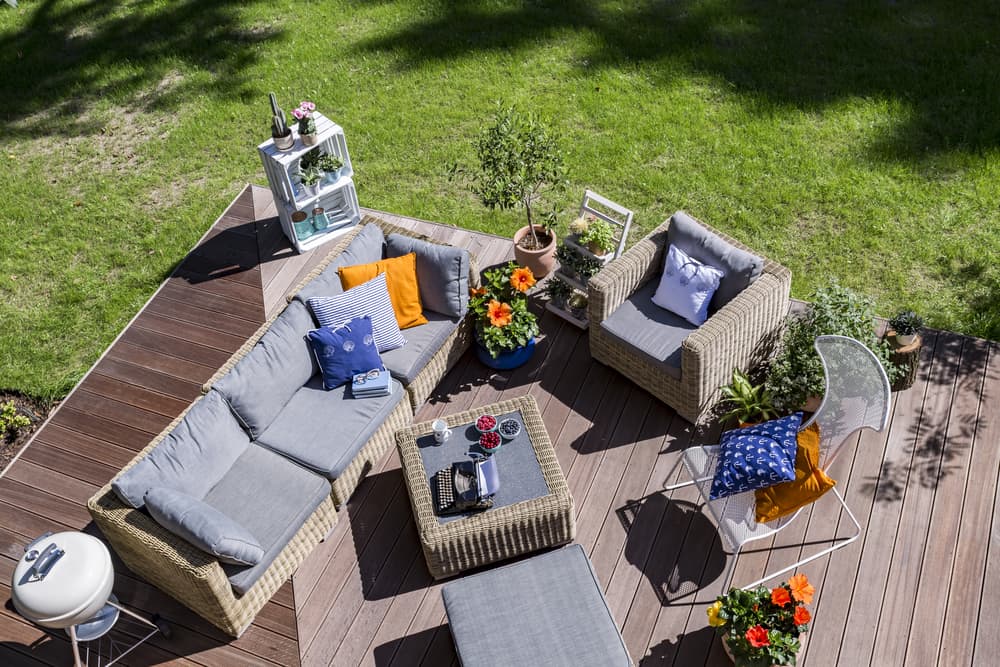
Unfortunately, when people try to create the perfect patio, planting is often not a primary concern, but planting really is the thing that will make or break a patio design.
“It really comes down to thinking about your senses and what’s going to stimulate them, and usually, it’s colour, smell and movement,” explains Danny Clarke, a Gardening Expert and TV Personality.
The plants you choose can play a key role in creating the right environmental conditions; they can determine not only the look but also the overall feel of the space.
Use Surrounding Planting
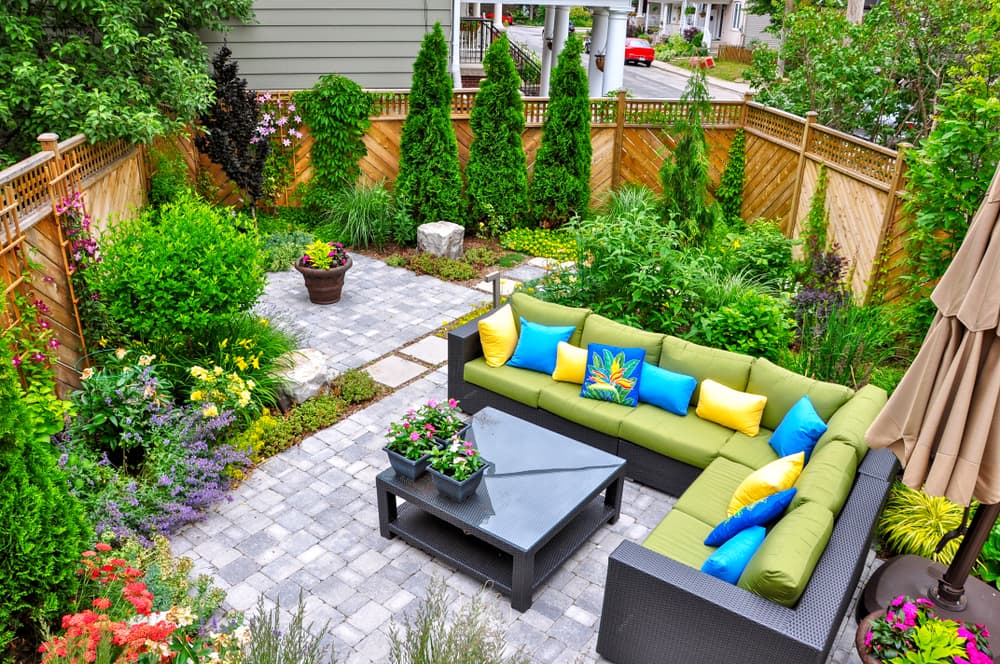
It can be a good idea to create planting that cocoons or surrounds the main entertainment areas.
This can not only make the space feel more private, it can also create a calm and cozy feel.
The key is to choose plants which are beautiful, and perhaps which smell wonderful too – and to select plants which add to the appeal of the space without making it feel too hemmed in or constricted.
Curved, circular and more organic shapes might not be the first options which spring to mind, but breaking out of a box-like mentality, and breaking up squares and rectangles, can be a good idea.
“Consider vertical gardening more than anything,” Danny says.
“You could install an arch at the top of a patio that you could walk through, which you could add a climber, like Clematis armandii, which has a lovely scent, especially in the spring and summer months.
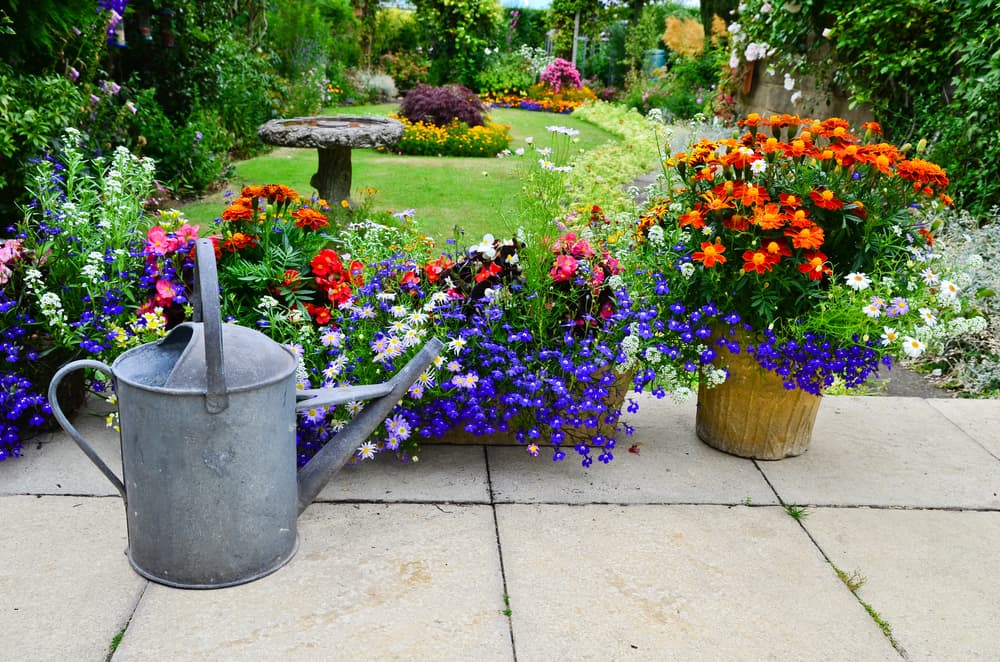
“Star jasmine is another great climber that could go over an arch and has a great scent.
“It also looks good and has lovely creamy flowers that are star-shaped, hence the name.”
More natural and sinuous shapes for patio entertainment areas can help the space feel more welcoming and can also help to blend in the patio area with the rest of your garden.
Our plant choices are designed to create a diffuse barrier between the patio and the rest of the garden, which will provide an intimate and enclosed feel without overly restricting light or views of the rest of the space.
Taller perennials, like Lupins and Agastache at the centre of the bed, and shorter plants towards the edges create soft shapes and interesting texture and shape combinations that add to the feel of the patio zone.
Decide On A Style & Colour Scheme

Of course, the shapes and style you go for are up to you – stylistic preferences can be a very personal thing.
But to create a cohesive style, it is important to determine your own style preferences before you begin.
Are you looking for a natural and rustic look? Or do you prefer something much more sleek and streamlined?
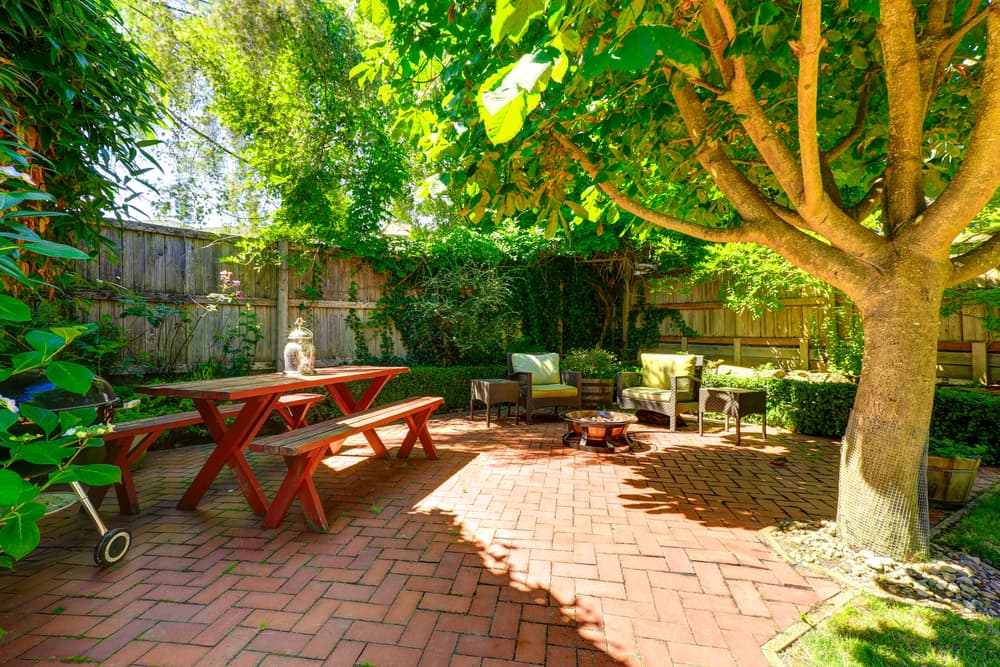
Our own design shows a potential scheme for a patio with a relaxed and organic feel; one which will work well for garden wildlife, as well as for you.
Some people might worry about placing plants which will attract wildlife close to where they want to sit and dine – but having a patio space where you can hear buzzing bees, watch butterflies and other insects, and the birds, really can enhance the space.
In fact, with plenty of flowering plants to attract them, the insect life is far less likely to bother you.
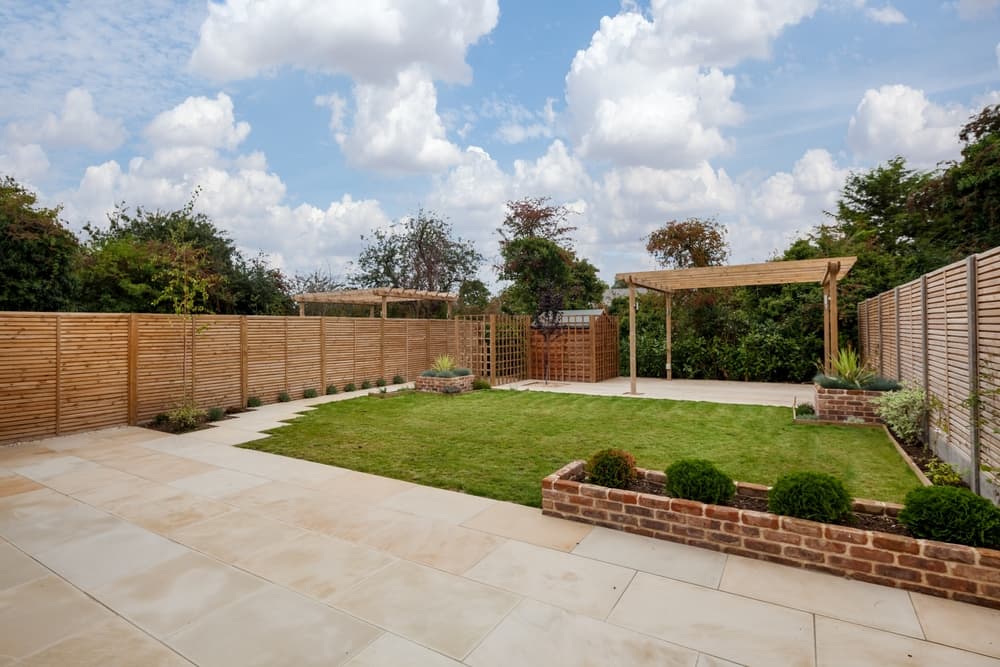
It can be a good idea to have a colour scheme in mind for the planting around your patio.
By choosing two or three key colours, and choosing plants within that colour scheme, you can create a relaxing and beautiful design that feels more cohesive, and less busy.
We’ve chosen a range of plants that will work well for a sunny, south-facing patio, largely in shades of green, lilac and blue.
Choose Plants That Work For The Location
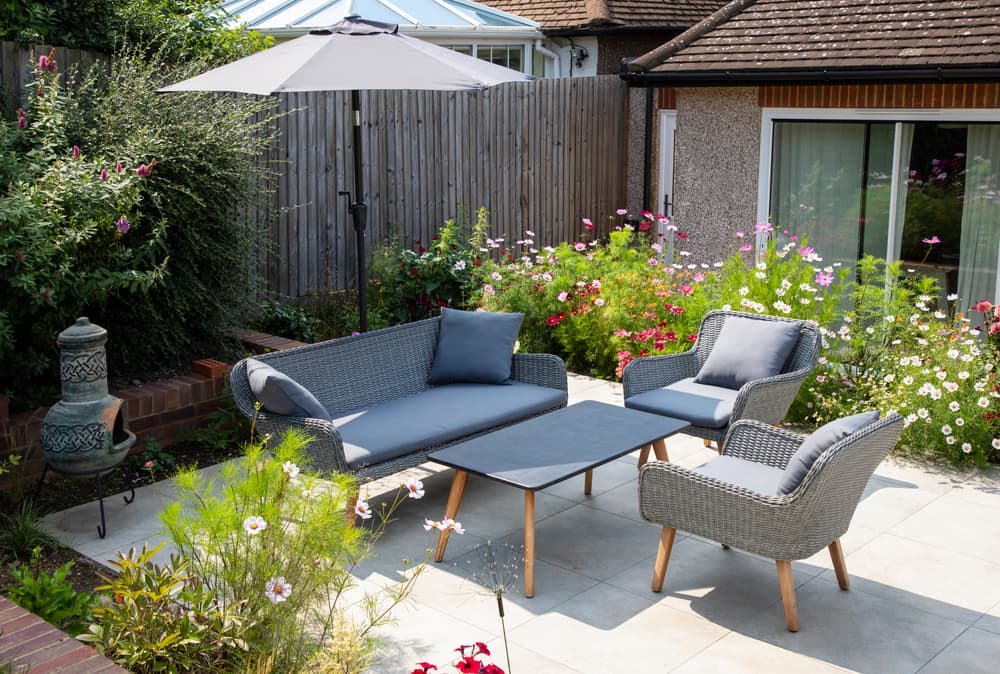
While you may get a lot more use out of a patio in the summer months, it is a good idea to choose plants that look great over as much of the year as possible.
Perennials offer great value for money as they will come back year after year, whilst annuals are great for pollinators, as Ann-Marie explains:
“For me, annuals are super important, and I have a couple of beds at the edge of my patio deck with tons of pots where I just experiment with new combinations and plants.
“I think with growing annuals, you can sow directly into pots and you don’t have to have the labour and intricacies of sowing and potting on.
“You’ll be amazed at what you can achieve and year after year it will look very different for you.”
Our plant choices for this example design aim to provide blue and lilac blooms throughout as much of the year as possible, with some evergreens to preserve a green, lush feel even through the winter months, and interesting ornamental grasses which fit in with the colour scheme.
Plants in our design:
- Evergreens like Ivy, Ceanothus, Bay, Rosemary, Lavender etc.
- Culinary herbs like Bay, Rosemary, Hyssop, Agastache, Echinacea etc.
- Beautiful flowering shrubs/ sub-shrubs: Lilac, lavender, hyssop, lithodora diffusa…
- Beautiful herbaceous perennial flowers: Lupins, Veronica, Agastache, Salvias, perennial Cornflowers, Eryngium etc.
- Ornamental grasses – e.g. blue festuca grasses.
- Edible plants: patio fruit tree, cardoon, and many common annual crops in pots and containers, including edible climbers which can be grown up the trellis against the fence.
As you can see, in our design, we’ve not just thought about planting for ornamental appeal and wildlife, we’ve also suggested that it is a wonderful idea to grow culinary herbs, fruits and vegetables in pots, close to areas where you will be sure to keep a close eye on them.
“Any plant with any scent is great and colour, of course, is also important,” says Danny.
“Tactile plants that are nice to feel are also good choices.”
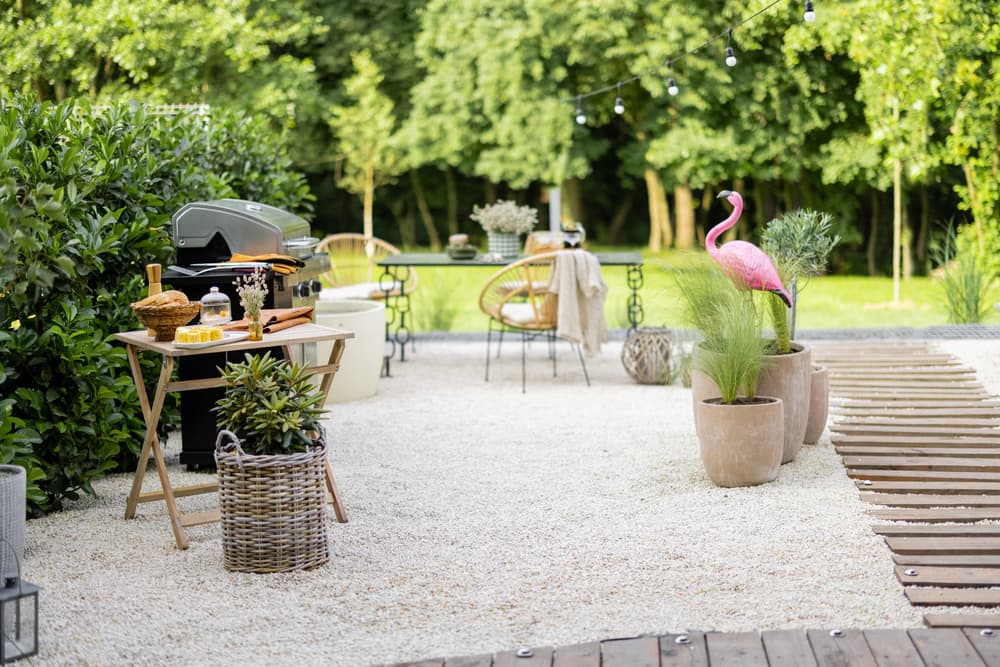
“I think it’s always nice to have scent around patio areas, but it depends on the light levels and orientation as to what you can plant,” Flo agrees.
“If your area is in full sun, you can plant lavender or other aromatic plants around the patio and may also want to think about evergreen plants as well.
“If it’s near the house, it might be something that you want to look good all year round.
“Ornamental grasses or plants that generate a lot of movement in the wind are also nice to have around patios.”
There are also a wide range of edibles you can grow in a patio container garden – from fruit trees to annual crops.
Trellising to one side can enliven a fence, and allow you to grow edible climbing plants.
Our design also highlights another key issue – water.
Harvesting rainwater is a key sustainable strategy that will help you maintain your container garden throughout the year.
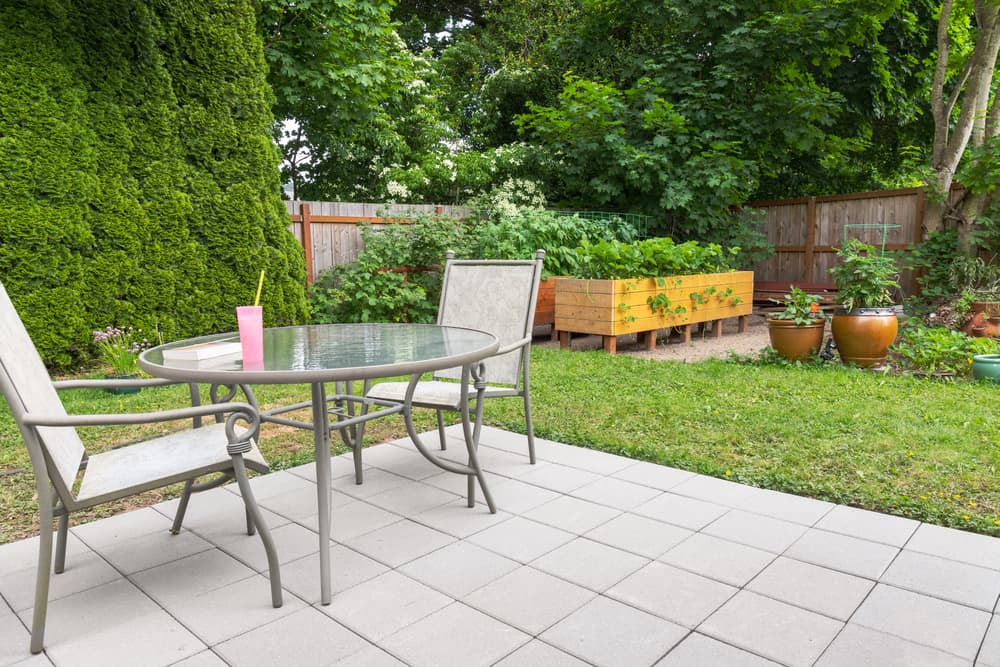
When designing a patio adjacent to your home, it can often be a good idea to consider attaching a collection barrel or butt to a downspout from your guttering.
Of course, there are many considerations and things to think about when creating a patio perfect for summer parties and entertaining family and friends.
Hopefully this article and our example patio design will inspire and help you figure out the perfect plans for your own particular garden.
